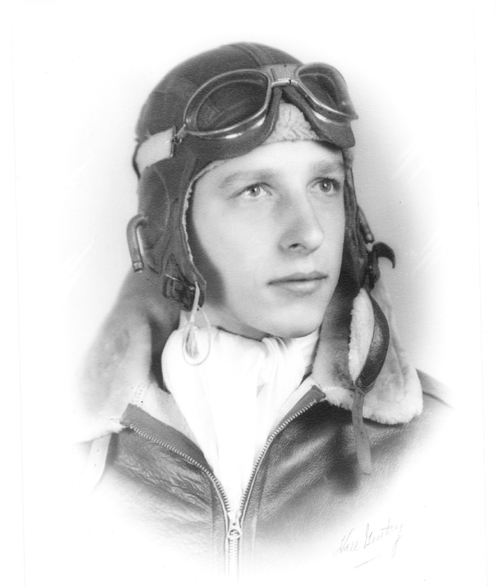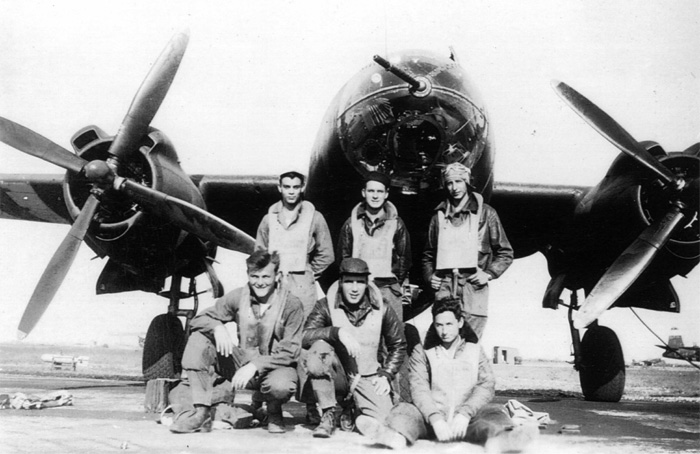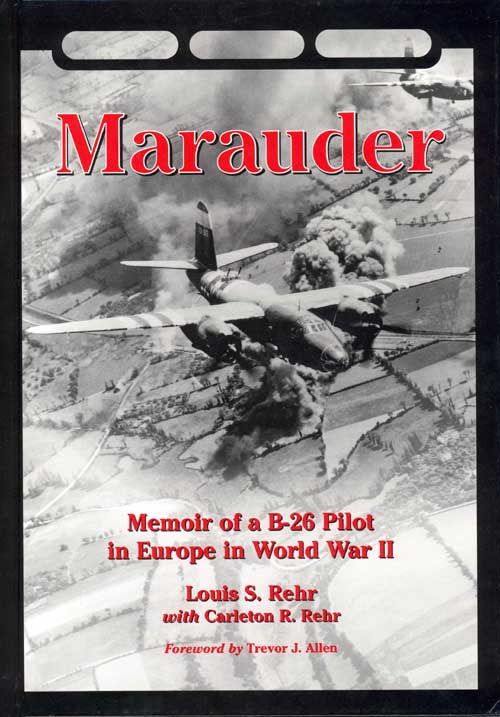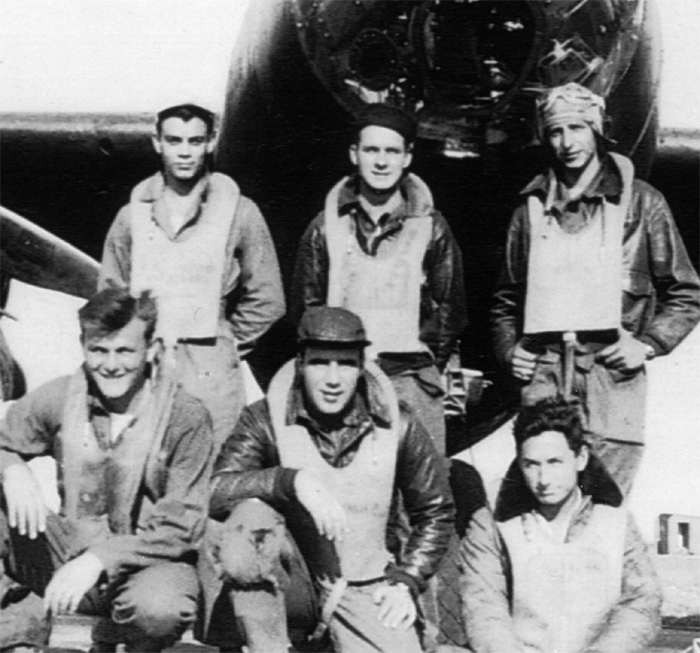
Photo of Lou in front of monument
Samoussy, France, 2007. Lt. Col. Louis S. Rehr standing in front of the
monument dedicated to the men of the 323rd who gave their lives for the
liberation of France. This monument, erected by the Franco American
Association of the Aisne, is located near the former Laon-Athies Airdrome,
where the 323rd was based from October 1944 to February 1945
Lt. Colonel Louis S. Rehr began his military life at 14 when he entered
Indiana’s Culver Military Academy, known as the “West Point of secondary
schools.” Even during the Depression, Culver maintained its long tradition
of preparing young men for college while training them to be dedicated
soldiers and patriotic citizens.
Before he graduated in 1938, Rehr distinguished himself as a cadet in the
mounted Field Artillery unit by earning a position in its honor
organization known as the Four Gun Drill Team. In 1936, he also won the
national rifle championship for military schools. With additional summer
training at Fort Knox, Kentucky, he graduated as a second lieutenant.
Although Rehr held a commission in the Field Artillery, his dream was to
become an Army Air Corps pilot. During the summer of 1940, he was accepted
into the government initiated Civilian Pilot Training Program, which was
established in response to the growing threat of war abroad. He trained at
Ohio’s Cleveland Airport, where the year before, he soloed his first
aircraft. By summer’s end he earned his private license.
During Rehr’s junior year at Washington and Lee University, Army Air Corps
recruiters visited the campus, and he jumped at the opportunity to sign
up. He was inducted into the Corps in July 1941, five months before the
bombing of Pearl Harbor.
At his graduation from primary flight school at Hicks Field, Fort Worth,
Texas, he was awarded the Military Achievement Award given by the World
War I Flyers of Fort Worth. After completing his basic training at
Goodfellow Field, San Angelo, Texas, and advanced training at Kelly Field,
San Antonio, Texas, he earned his wings on February 13, 1942, the Class
of 42B.

2nd Lt. Louis Rehr, February 13, 1942
Following graduation, he remained at Kelly as an advanced
instructor. Six months later he transferred to Waco, Texas to train
advanced students in twin-engined aircraft. Motivated by a desire to be
assigned to a combat unit, he volunteered to instruct in the Martin B-26
Marauder, despite this bomber’s reputation as a “winged coffin.”
“Sure the Marauder was faster, heavier and noisier than anything I'd flown
before,” he said. “But I was convinced that flying it for the first time
would not be a terrifying event.”
Beginning in February 1943, he spent nearly a year as a Marauder
instructor at Del Rio, Texas, and Dodge City, Kansas. Finally, in January
1944, his commanders approved his repeated requests for transfer to a
combat unit. His orders were to report for transitional training at
Barksdale Field, Shreveport, Louisiana. By the time he arrived in England
in May 1944, Captain Rehr had over 2,000 hours of flight time, half of
those in the Marauder.

Photo of the Rehr crew before a mission.
Beaulieu, England. The Rehr crew before a mission.
Standing left to right: Lt Victor Jacobs, bombardier; Lt. Joe Searle,
copilot; Capt. Lou Rehr, pilot. Front row left to right: Sgt. James
Knight, engineer/gunner; S/Sgt. James Alexander, radio/gunner; Sgt.
Charles Allen, tail gunner.
He served overseas from June 1944 to July 1945 with the 323rd Bombardment
Group, also known as the “White Tailed Marauders.” Assigned to the 456tth
Bombardment Squadron, Rehr became its assistant operations officer in
December 1944, then operations officer the following month. From February
to July 1945, Major Rehr held the position of squadron commander.

Photo of Rehr Crew
Rehr crew with "Ole 33 Gal", one of Rehr’s favorite
Marauders. Left to right: Lt. Victor Jacobs, bombardier; Maj. Louis Rehr,
pilot; Lt. Frank Burgmeier, navigator; Lt. James Siegling, copilot.
During his combat duty, he flew 60 missions, 23 of which were group or box
leads. Rehr earned 12 air medals and five battle stars for campaigns in
Normandy, Northern France, Rhineland, Ardennes-Alsace, and Central Europe.
He was awarded two Distinguished Flying Crosses for bombing missions flown
over Germany on November 19, 1944 and again on February 14, 1945. He is
also the recipient of the French Croix de Guerre with Silver Star. His
bomb group earned a Distinguished Unit Citation for its extraordinary
bombing successes from December 24-27 during the Battle of the Bulge.
After VE Day, he directed the aircraft disarmament activities at Kempton,
Germany until his return home in July 1945.
Rehr served with the Air Force Reserves until 1958 when he was discharged
with the rank of lieutenant colonel.
In October 2004, the Franco American Association of the Aisne dedicated a
monument to the sacrifices of the 323rd Bombardment Group. It is located a
short distance from the former Laon-Athies Airfield in Samoussy. Many who
were present at the ceremony had vivid memories of the German occupation
and their liberation by the Americans. Lou Rehr and his wife Carleton were
honored guests at the dedication.
Lou Rehr is the author of Marauder Memoir of a B-26 Pilot in Europe in
World War II, published by McFarland.

Marauder: Memoir of a B-26 Pilot in Europe in World War II by Louis S.
Rehr
Permalink: http://amzn.com/0786443677

Beaulieu, England. The Rehr crew before a mission.
Standing left to right: Lt. Victor Jacobs, bombardier;
Lt. Joe Searle, copilot; Capt. Lou Rehr, pilot.
Front row left to right: Sgt. James Knight, engineer/gunner; S/Sgt.
James Alexander, radio/gunner; Sgt. Charles Allen, tail gunner.
Lou has not been able to locate James Knight, James
Alexander, or Charles Allen and would like to talk with them
again.
|